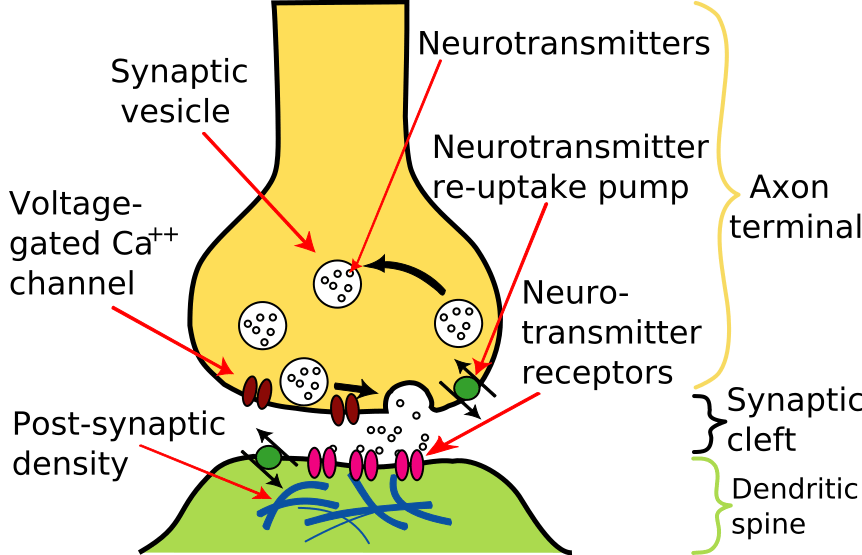Key Difference – Synapse vs Synapsis
Synapse and Synapsis are two important terms in the fields of neuroscience and cell biology respectively. Synapse is the gap area between two adjacent neurons in which nerve impulse is transmitted from one neuron to the other neuron. Synapsis is the fusion of homologous chromosomes during the meiosis. Homologous chromosomes; one from each parent (maternal chromosome and paternal chromosome) come closer and pair with each other forming a tetrad. Tetrad formation is important in order to exchange genetic material between homologous chromosomes by the process called crossing over. The key difference between synapse and synapsis is that synapse is a small junction where two neurons come closer during the signal transmission while the synapsis is the connecting of homologous chromosomes to form a tetrad during the meiosis.
CONTENTS
1. Overview and Key Difference
2. What is Synapse
3. What is Synapsis
4. Similarities Between Synapse and Synapsis
5. Side by Side Comparison – Synapse vs Synapsis in Tabular Form
6. Summary
What is Synapse?
Neurons are the basic units of the nervous system that facilitate the impulse transmission. Neurons are not physically connected, and there is a gap between orderly arranged neurons. Synapse is the area where two neurons come closer to send and receive signals. Signals are transmitted as an action potential. When the action potential reaches the end of the first neuron (presynaptic neuron), the synapse facilitates the handover of the action potential to an adjacent neuron that is known as post synaptic neuron. Presynaptic membrane becomes positively charged, and it releases neurotransmitters into the synaptic cleft. Neurotransmitters are the chemical messengers of the nervous system. They are stored in the vesicles of the presynaptic neuron. They diffuse through the synaptic cleft and bind with the receptors located on the surface of the post synaptic membrane. Likewise action potential propagates through neurons until it receives by the target organ.

Figure 01: Synapse
The synapse is located in the ganglion. Ganglion houses millions of synapses. There are two types of synapses namely chemical synapse and electrical synapse. Chemical synapse uses chemical messengers to communicate between neurons while electrical synapse uses ion flows directly to between cells.
What is Synapsis?
In the evolutionary point of view, variability among the gametes is important in order to produce genetic variability among the offspring population. Gametes are formed by the cell division process called meiosis. Genetic materials are exchanged between mother chromosomes and father chromosomes during the meiosis. It is an important phenomenon since recombinant chromosomes are formed, and produced gametes differ genetically from each other. During the initial stage of meiosis, homologous chromosomes connect with each other.
Maternal chromosome fuses with the homologous paternal chromosome creating a special structure called a tetrad. This fusion of homologous chromosomes is known as synapsis. Synapsis is a unique feature of meiosis, and it happens during the prophase I. The word tetrad is given with the meaning that, this structure includes for sister chromatids.

Figure 02: Synapsis – Tetrad
When tetrad is formed, it is easy to share genetic material between nonsister chromatids in a homologous chromosome pair. It is the process called crossing over. Complete exchange of genetic material between homologous chromosomes occurs in the crossing over, and it produces recombinant chromosomes.
What are the Similarities Between Synapse and Synapsis?
- Synapse and synapsis are extremely important processes of living organisms.
- Both synapse and synapsis occur between two things. Synapse occurs between two neuron cells and synapsis occur between two homologous chromosomes.
What is the Difference Between Synapse and Synapsis?
Synapse vs Synapsis | |
| Synapse is the junction where two neuron cells come closer to propagate nerve impulse. | Synapsis is the fusion of two homologous chromosomes during the meiotic cell division. |
| Function | |
| Synapse facilitates the nerve impulse transmission between the gaps of the neurons. | Synapsis facilitates the exchange of genetic material between homologous chromosomes and the production of recombinant chromosomes. |
| Field | |
| Synapse is a term used in neuroscience. | Synapsis is a term used in cell biology. |
| Associated Objects | |
| Synapse occurs between two neuron cells. | Synapsis occurs between two chromosomes. |
Summary – Synapse vs Synapsis
Neurons are the cells of the nervous system. They are not physically connected to each other. Neurons are connected by synapses. Synapse is the connection region between two neurons, it propagates the action potential. Synapse facilitates the signal transmission from the axon of a presynaptic neuron to dendrites of the postsynaptic neuron or the target neuron. It occurs via chemical messengers called neurotransmitters. Synapsis is an important feature of meiosis that happens in the prophase I. It is the process of connecting homologous chromosome to form tetrads. Homologous chromosomes fuse with each other by all along with their lengths. It facilitates the exchange of genetic materials between nonsister chromatids of the homologous chromosomes. It is the process called crossing over, and it produces recombinant chromosomes and finally genetically variable gametes. This is the difference between synapse and synapsis.
Reference:
1.“The synapse.” Khan Academy. Available here
2.“Synapsis.” Wikipedia, Wikimedia Foundation, 20 Feb. 2018. Available here
Image Courtesy:
1.’Synapse Illustration2 tweaked’By Nrets (CC BY-SA 3.0) via Commons Wikimedia
2.’Tetrad’By internet (CC BY-SA 2.5) via Commons Wikimedia
ncG1vNJzZmivp6x7pbXFn5yrnZ6YsqOx07CcnqZemLyue8OinZ%2Bdopq7pLGMm5ytr5Wau26%2F2KeYqauVYq6vsIyvqmarqaOusb%2FIrGY%3D